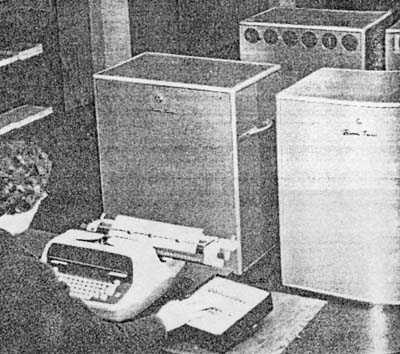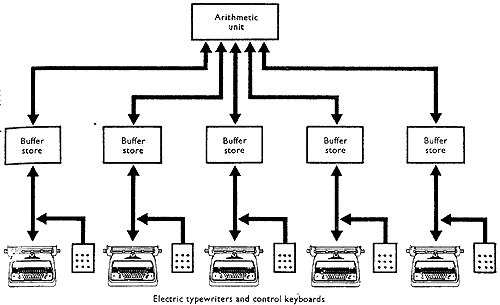Block & Anderson Bandatronic

Prototype Bandatronic installation.
Block & Anderson Bandatronic
Under the headline "Calculating Typewriters" the January-March 1961 edition of the British journal "Data Processing" had details of the Bandatronic System produced by Block and Anderson Limited:
"In a Bandatronic system, up to five electric typewriters are connected to a sterling [currency] arithmetic unit. Factors of a calculation entered on the keyboard of any one of the typewriters are transmitted to the arithmetic unit and the answer obtained is automatically transferred back to the typewriter. Invoices, wage slips, loan accounts, contract notes and documents of a similar nature can all be prepared in this way.
Each typewriter operates independently of the others and the arithmetic unit is shared between them as the situation demands. Thus, in a single operation, tasks are completed which, previously, were broken down into two or even three separate clerical procedures. Bandatronic systems may be hired or they may be bought outright for £15,000 to £18,000 [about US$60,000].
Even to-day ready reckoners and desk calculators are often used to calculate invoice item prices which are then written in long-hand on the appropriate office documents. Later, this information is copy-typed on to the invoice that is sent to the customer.
To speed up this rather cumbersome though necessary clerical chore Block and Anderson Limited conceived the idea of combining the many clerical procedures and performing them in a single operation. While the invoice is being typed the necessary calculations are performed and, at the appropriate moment, the answer is automatically printed in the "amount" column of the document. Where applicable, surcharges and discounts are also calculated automatically and added or subtracted as required. Finally, when all the entries have been completed, the total for the order is typed by the machine at the foot of the invoice.
Having decided which operational features were desirable, Block and Anderson contracted with Pye Limited to design and build a machine that could perform these tasks. The result of this co-operative effort is a new data processing svstem called the Bandatronic. It comprises up to five electric solenoid-operated typewriters connected to a specially designed electronic arithmetic unit.
Calculations are performed in sterling [currency] and the answers derived are accurate to two decimal places of a penny or may be rounded-off to the nearest penny. Totals and sub-totals are stored separately for each typewriter and a central store is provided to which these totals may be transferred so that grand totals can be compiled.
Discounts are typed in red and are automatically subtracted from totals held in store. Net values are typed in black and are added to the totals in store.
The reason for connecting as many as five typewriters together in a common system is that the calculating capacity of the arithmetic unit is far beyond the needs of one typist operating one typewriter; consequently, with the time of the unit shared between five machines the costs of operation are materially reduced. This idea of improving the economy of operation by "time-sharing" has, of course, been borrowed from the field of computer technology where it was originally developed. ..."

Electric typewriters and control keyboards diagram showing the arrangement of a Bandatronic system equipped with five typewriters
"... The Bandatronic is not intended to be used as a general-purpose calculator. The machine is set up before delivery to perform the range of work specified by the customer. Hence there is no such thing as a standard Bandatronic system. Each typewriter can perform four different programmes and the operator selects the one required by pressing a button on a control panel.
The prototype machine is equipped with two typewriters and the operation of this machine will be described because it illustrates some of the facilities available with a Bandatronic.
Each typewriter is connected by cable to a cabinet that contains five data storage registers.
Two of these registers store the factors of a calculation, the third stores the answer when it is received from the arithmetic unit and in the fourth and fifth registers a sub-total and a total are compiled. Each register can accommodate sterling amounts up to a maximum of £100,000,
The typewriter cabinets, in turn, are connected by cable to the sterling arithmetic unit which can perform the three basic operations of adding, subtracting and multiplying. A calculation containing the maximum number of digits possible in the multiplier—that is ten—takes half a second to complete. This is slow by electronic computer standards but more than adequate for the needs of the Bandatronic system where all data are entered manually on keyboards.
In addition to the arithmetic unit, the central assembly contains a register in which grand totals are compiled. The prototype has one register, but as many as three may be fitted. A small push-button control panel is placed next to each typewriter and, as mentioned earlier, is used by the typist to select the programme to be performed and also to control the operation of the system. ...
... Initially, a Bandatronic equipped with one or two typewriters can be installed and, later, as the volume of work to be handled increases, the system can be extended by the addition of further units."
The main features are:
- Electronic arithmetic unit.
- Pre-programmed routines for calculating invoices. The program to be used is selectable by the operator.
- Three functions - Addition, Subtraction, Multiplication.
- Up to five typewriters for input and output.
The Bandatronic is an early electronic calculator of about the same period as the ANITA Mk VII and ANITA Mk 8, but it is a much more
specialised machine and in no way can be considered to be a desktop calculator.
Nevertheless, it is still an interesting early electronic calculator, but, infuriatingly, no details are given about the technology used.
The Pye company which produced the machine for Block and Anderson was a major manufacturer of industrial control equipment and consumer radio and electronics goods. Pye briefly marketed three models of hand-held electronic calculators in the 1970s, made for them in Japan and Malaysia.
The price was very high - about the same as a large house at that time - so it is doubtful that many Bandatronic systems were sold.
If you have any information at all about the Bandatronic please contact us.
Other companies produced similar electronic accounting machines that were manufactured to perform specific tasks and were built into large desks. Although parts of their systems perform the functions of a calculator they were not the desktop calculators that we recognise.
Electronic Desk
Calculators
Vintage Calculators
Text & photographs copyright, except where stated otherwise, © Nigel Tout 2000-2026.